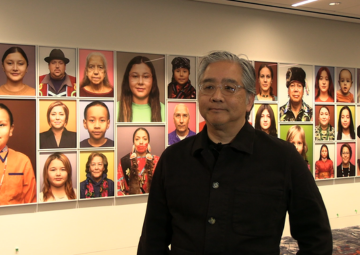
Portraits of a Land Acknowledgement
Kevin Miyazaki wanted to create a series of portraits. This was his artform, and being born and raised in Milwaukee, he wanted a collection of the people that live here to be on display and represent the city to outsiders and visitors of Baird Center.
This was his initial idea for a commissioned piece for the WE Energies Foundation Art Collection. As conversations unfolded, its focus began to evolve. A fourth-generation Japanese American, Miyazaki has long explored themes of identity and ethnicity in his work, often through the lens of Asian American history—from migration to incarceration. He realized that the deeper history of a place, particularly told through the lives of those who have inhabited it across generations, could also serve this purpose.
This shift in perspective led to the creation of Acknowledgement, a piece Miyazaki describes as a form of land acknowledgment—a respectful recognition of Indigenous Peoples as the original stewards of the land. His aim was to create something that not only honors those who came before but also educates, offering insight into the layered histories that shape Milwaukee.
“The word ‘acknowledgment’ is a powerful word,” Miyazaki said. “It means that non-Native people like myself have addressed and accepted the true history of a place. For this project, its addressing and accepting the history of Native Americans in this country. I hope this work makes people think more about that.”
Miyazaki devoted over a year to this single project. Much of that time unfolded in quiet conversations at the Indian Community School in Franklin, Wisconsin—where more than 350 students, representing 40 tribal nations, gather in a space rooted in culture and care. The story was so important he wanted to make sure he would do it justice?
Miyazaki understood the weight of that question. He reflected a lot on the imbalance that lives inside a lens—the quiet power of the photographer, the authority in a single frame. He didn’t want to take that power for granted. Instead, he invited collaboration, offering space rather than instruction, presence rather than control.
This began in the details. He worked to create a low-key atmosphere where each person appeared as they chose. Some chose to come wearing traditional tribal dress while others wore their favorite outfit.
The portraits also needed to reflect the present. No black-and-white echoes of a distant past. These portraits were meant to be contemporary. What emerged was not just a series of images, but a colorful display of a people and this place.
“I always hope my artwork raises questions,” Miyazaki said. “Those questions may be political. They may be about racism, about historical wrongs, about immigration or migration. When I’m making these large portrait series, in effect, I’m creating an encounter between people, between the viewer at the subject looking directly at the viewer. As brief as that encounter may be, when people look at others in the eye, hopefully that opens the door to more understanding, curiosity and empathy.”
This connection forged throughout the process has continued past the instillation. Miyazaki continued his project with the creation of a book for all 500 members of the school community that included his portraits, including some that didn’t fit into the installation. The book was completed and donated in 2024. It will also feature photos of the 178 acres of land the school sits on.
Miyazaki said this would connect their land with its first people. He also sponsored artist visits to the school and donated contemporary art books to the school’s library. His work, and his actions, will continue to lift up the voices and stories that are often overlooked.
“I have the viewers attention, even if for only a moment,” Miyazaki said. “It’s my hope that people will think more about the true history of the land and where they’re standing. If they’re a visitor to our city, they will go home and maybe think about the first persons that lived on their land and the history of where they came from.”
Acknowledgement is part of the We Energies Foundation Art Collection located at the Baird Center. Kevin Miyazaki is one of the thirty-three artists, most from Milwaukee, Wisconsin, or with special ties to the area, who have works featured in the collection. You can discover more about the artists and their works at https://bairdcenter.com/art-collection/